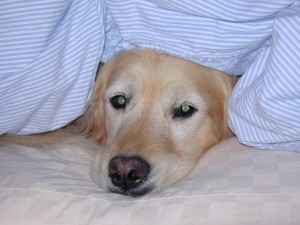< UPDATED 19NOV19 >
< A short link to this page – http://bit.ly/PrevSepAnx >
<A version of this article was published in The Maine Edge on March 2, 2016 – click to view>
 Dogs are social animals and actively seek out our companionship. They can quickly become accustomed to being part of a group 24 hours a day, seven days a week. Whenever a new dog is brought into a home, especially a young, playful puppy, people have a tendency to interact with them constantly. While this interaction is a very important part of socialization and bonding, you need to make sure that you are not setting your puppy up for a big disappointment when you must leave him at home alone. Including some “alone training” right from the beginning will be beneficial to both your puppy and you.
Dogs are social animals and actively seek out our companionship. They can quickly become accustomed to being part of a group 24 hours a day, seven days a week. Whenever a new dog is brought into a home, especially a young, playful puppy, people have a tendency to interact with them constantly. While this interaction is a very important part of socialization and bonding, you need to make sure that you are not setting your puppy up for a big disappointment when you must leave him at home alone. Including some “alone training” right from the beginning will be beneficial to both your puppy and you.
Older dogs, depending on their previous circumstances, might also need to learn how to cope with being alone. For example, a dog that was housed in a shelter or kennel situation where other dogs and people were always around may have trouble coping being by themselves.
If you have not already done so, start leaving your puppy/dog alone for brief duration’s throughout the day. He needs to learn that 1) people are not always around and 2) you will come back. When leaving your puppy/dog alone, put him in his crate or a puppy-proof room. Be sure to give him some of his favorite chew toys so he can have some fun while he awaits your return. Do not make a big deal out of leaving. Just pop the puppy/dog in his area and leave.
Your puppy/dog may start to whine or bark when you leave. This is very normal. Your first impulse may be to return to the puppy/dog and try to calm him, however, that is the worst thing you can do. If you want him to stop whining, you must make sure you do not reward the puppy/dog for whining. Do not pay any attention to your puppy/dog and do not let him out until there is a lull in the whining. Reward him for being calm and quiet.
Leaving your puppy/dog at home, at the veterinarians, at the groomers or a boarding kennel should also be a very low-key, non-emotional event. Likewise, the same applies when returning to your puppy/dog. If you make leaving or returning into a big event, with lots of cuddling and petting, your puppy/dog is more likely to be stressed by your arrivals and departures. You can, and we hope you do, miss your puppy/dog when he is not with you. We just do not want to let him know that.
Start your alone training by building time slowly. Five to ten minutes is a good place to start if your puppy/dog has never been out of your site for that length of time. Like all training, we want to work in small achievable increments that the dog can handle. Continue leaving your puppy/dog alone for longer and longer periods of time.
If this behavior does not improve after a few days, consult with your dog’s veterinarian. They will probably prescribe medications and may also refer you to a Veterinary Behaviorist or a Certified Dog Behavior Consultant (CDBC). They can help you develop a behavior modification protocol for you and your dog. You can find a list of these individuals in Maine at http://bit.ly/MEPetPros
If your dog already exhibits destructive behaviors such as digging, scratching or chewing on themselves, house soiling, destruction of objects, extreme vocalization, constant pacing, digging and scratching at exits such as doors and windows in an attempt to reach you, and following you excessively, never letting you out of sight, then you should immediately discuss this situation with your veterinarian. These are symptoms of separation anxiety which may require treatment with appropriate medications and a behavior modification program specific to separation anxiety. Your veterinarian will probably refer you to a Certified Dog Behavior Consultant (CDBC) to develop a behavior modification plan for your dog and your family. Resolving separation anxiety will typically involve changes in your family’s behavior in addition to your dogs. This is typically not an easy problem to resolve and becomes more difficult to resolve the longer it goes on. That is why teaching your dog to cope with being alone is an excellent investment of your time.
Recommended Resources
Alone Training – http://blog.greenacreskennel.com/2014/08/01/dog-training-alone-training/
Podcast – Separation Anxiety with Dr. Dave Cloutier from Veazie Veterinary Clinic – http://blog.greenacreskennel.com/2017/05/01/podcast-separation-anxiety-with-dr-david-cloutier-from-veazie-veterinary-clinic/
Maine Pet Care Professionals We Recommend – http://bit.ly/MEPetPros
Canine Behavior – ADAPTIL™/DAP COMFORTZONE™ – http://blog.greenacreskennel.com/2014/08/14/canine-behavior-adaptild-a-p-comfortzone/
Canine Behavior – Understanding, Identifying and Coping with Canine Stress – http://blog.greenacreskennel.com/2015/11/01/canine-behavior-understanding-identifying-and-coping-with-canine-stress/
Dog Behavior – Crate Habituation to Reduce Anxiety – http://blog.greenacreskennel.com/2016/01/30/dog-behavior-crate-habituation-to-reduce-anxiety/
Bach Flower Remedies – Bach Rescue Remedy® – http://blog.greenacreskennel.com/2015/06/22/bach-flower-remedies-bach-rescue-remedy/
______________________________________________________________________________
Don Hanson is the co-owner of the Green Acres Kennel Shop (greenacreskennel.com) in Bangor. He is a Bach Foundation Registered Animal Practitioner (BFRAP), Certified Dog Behavior Consultant (CDBC), Associate Certified Cat Behavior Consultant (ACCBC) and a Certified Professional Dog Trainer (CPDT-KA). He produces and co- hosts a weekly radio show and podcast, The Woof Meow Show heard on The Pulse AM620 WZON and streamed at http://www.wzonradio.com/ every Saturday at 9 AM. A list of upcoming shows and podcasts of past shows can be found at www.woofmeowshow.com. Don also writes about pets at his blog: www.words-woofs-meows.com.
©20NOV19, Donald J. Hanson, All Rights Reserved <Click for Copyright and Use Policy>


![[ File # csp15483120, License # 3214320 ]<br /> Licensed through http://www.canstockphoto.com in accordance with the End User License Agreement (http://www.canstockphoto.com/legal.php)<br /> (c) Can Stock Photo Inc. / stefan11 [ File # csp15483120, License # 3214320 ] Licensed through http://www.canstockphoto.com in accordance with the End User License Agreement (http://www.canstockphoto.com/legal.php) (c) Can Stock Photo Inc. / stefan11](https://blog.greenacreskennel.com/wp-content/uploads/2015/11/dog-broken-through-ice-canstockphoto15483120-300x206.jpg)


